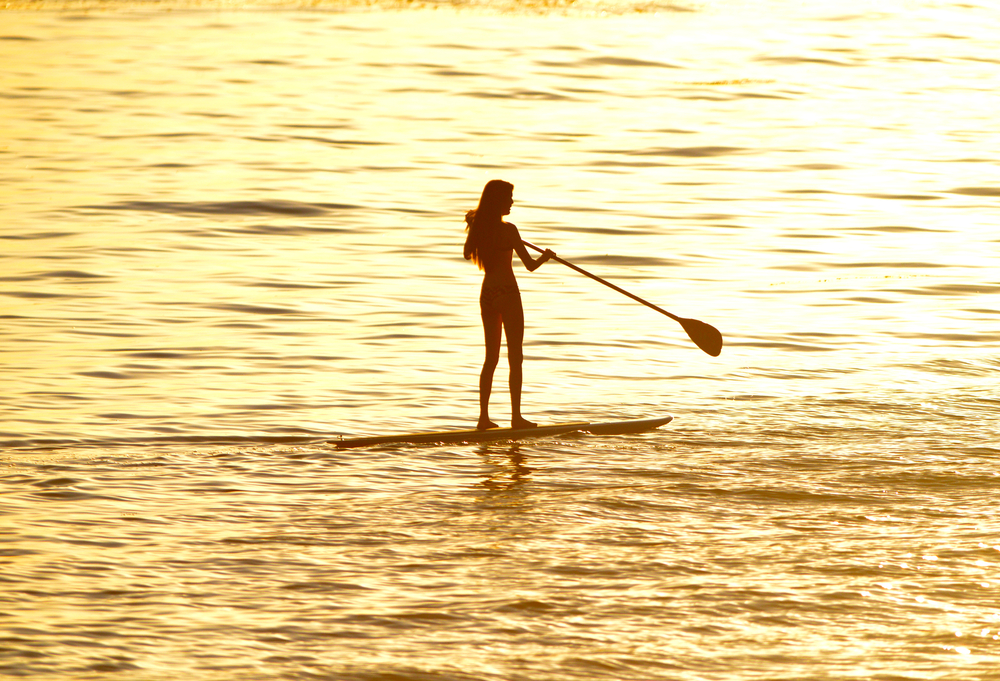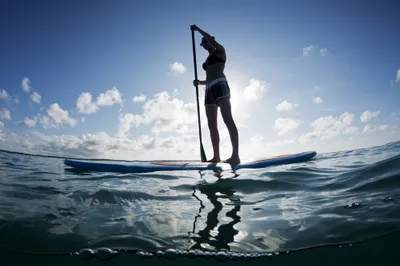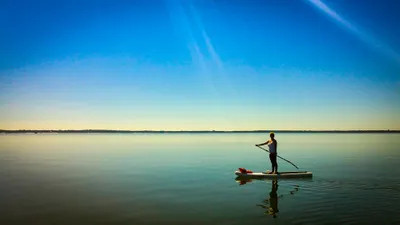Every once in a while I like to step out of my comfort zone. However, when I decided to try paddle-boarding for the first time, you could say I literally glided beyond it 🙂
Let me set the scene…it was a humid summer day, the sun was high and beams radiated off the lake’s surface as I tried to root my feet and gain enough balance (or confidence, maybe both) to stand up and start paddling. Luckily, all of my yoga experience came to good use and with my balance sturdy, I began my paddleboard adventure.
1. Why Paddleboard?
During summer, I try to spend as much time outside as possible. That may mean, I forgo my regular yoga class or workout at the gym and look for outdoor fitness prospects on perfect summer days. Cue my desire to paddle board, a sport that’s been around since the 1940s, thanks to safety conscious surf instructors and lifeguards in Hawaii.
Paddleboarding, particularly if you do stand-up paddle boarding (or what’s known as SUP), is gaining momentum in North America. Today, you can’t venture out to the beach, cottage, river, or coast without seeing a paddle board glide by. However, paddle boarding not only gets you out into the great outdoors to enjoy the stunning scenery and fresh air, it also provides a pretty challenging full-body workout to boot.
2. Enjoy the Full-Body Benefits
You’ll definitely use more than your arms to power your board. Jump on and try to stand up. Right away you’ll feel the flexion in your core to stabilize your pelvis, abdominals, pine, and hips as you try to prevent unwanted body sway, remain coordinated enough to paddle, all while staying balanced on your board. Then there’s your legs (you won’t be able to forget them) as they twitch, burn, and every ligament surrounding your knees, ankles, and even in your feet root to keep you upright on a rather unstable surface.
Now that you’re stable as can be, you’ll call on the strength of your upper body to paddle. With each stroke of the paddle, you’ll no doubt feel muscles you’ve never used in your back, shoulders, biceps, triceps, and even a bit in your chest.
3. Paddleboarding vs. Other Water Sports
Now if you already water ski, kayak, or canoe (can you?), you’ll likely be drawn to paddle boarding. However, unlike many of the aforementioned water sports, paddle boards don’t sink or capsize so the sport is fairly safe for everyone, even younger children.
That doesn’t mean you shouldn’t take safety precautions in the water if you’re an unexperienced swimmer (i.e., life jacket and paddle buddy). However, I’m a life-long lake swimmer who paddle boarded in a calm lake (with sandbars) and I felt very safe on my own.
4. Paddle and Burn Calories
Akin to many other water sports, such as kayaking and canoeing, paddling any vessel will burn a ton of calories…while you’re enjoying a pretty sweet view I might add. Even paddle boarding against a light wind will burn roughly 400+ calories per hour.
You can increase the challenge and the caloric burn by paddling more quickly or for longer time durations. You can also boost the intensity of your paddle boarding workout by paddling against the current or adding extra weight (bring your pooch for a paddle). Sounds a lot more interesting then running on a treadmill, right?
5. Paddleboarding Provides Gentle, Low Impact Fitness
Now if you have joint issues (i.e., particularly knee or back issues) you may already be thinking that paddle boarding isn’t for you. However, keep in mind, other than the challenge of flexing muscles in your core, hips, legs, and arms, a day gliding on your board is gentle and low impact.
Now that I’ve come to enjoy paddle boarding, I do it every other day (or whenever I can get to the lake) for a great recovery workout following interval training, hot yoga, kickboxing, or a really long run the day before.
6. Mindful Meditation
You’ve likely heard me talk about walking mediation (or mindfulness), or the benefits of walking while mindfully focusing on the experience…each foot step, your surroundings, the feeling of the wind on your face and the sun on your back. While paddle boarding is a perfect exercise to employ a little mindful meditation.
Sure, you’ll have no excuse not to focus on every muscle in your legs, ankles, knees, thighs, and feet as you try to stay stable on your board. But being mindful in life is more than that—while you paddle you can shut out all your thoughts on family, work, and social obligations. Those can wait while you take a break from stress and enjoy your nearness to water. Now that’s some serious meditation.









